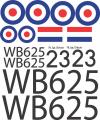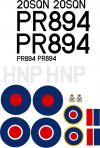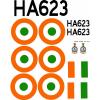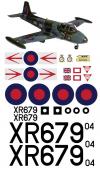Installation Instructions - 9X programing board V2.4
CLICK ON IMAGES BELOW TO ENLARGE
Installation Instructions: 9x Programmer Board
This page was written for Rev. 2.4 hardware.
Below is a pictorial showing the installation of our 9x solderless programming board. Click the thumbnails to see the full image. For Windows PCs you will also need to install drivers. For Mac or Linux users, please consult your friendly neighborhood Google search (or Bing, if you want to be ironic).
Contents: Your package includes one each of: A) the 9X SmartieParts programmer board; B) USB connector cable; C) bag of hardware containing 3 screws, 3 spacers and 1 nylon support; D) aux ISP cable; E) jumper cable; and F) LED cable.
Step 1: Turn your 9x radio over and remove the 6 case screws with a basic Philips style screw driver (the only tool you'll need for this whole process!)
Step 2: The two halves of your radio are connected with a single cable highlighted below. Carefully disconnect that cable by gently pulling while wiggling the connector side to side.
Step 3: If you're installing an optional LED backlight panel (not included) at the same time, remove all 9 small screws holding the main circuit board to the case (Take note that the four corner screws are slightly different than the 5 interior screws). If you're only installing the programmer (no backlight) then only remove the ones highlighted in blue in the picture below, which are going to be replaced by the three longer screws included in your kit, and skip to step 8 below.
Step 4a: The LED panel requires modification to work with our programmer board. Simply snip the thin black and red wires as close as possible to its small circuit board they are attached to, so that you are left with just the panel and the two wires. Splice the wires to the included LED cable (kit part 'F'). Please note that once you've removed the small circuit board, you should not apply any voltage to the wires directly (for example, to test which side of the panel lights up). Without the protection of the original circuit board or our circuitry, the panel will draw too much current and burn out almost instantly.
Step 4b: If you prefer not to modify your backlight as described above, that's fine. You may install it as per the panel's instructions instead, which means you remove the 9x 6-wire cable and plug it into the LED harness. Then you'll be plugging the white connector of the LED harness into the center SmartieParts board 6-wire socket (see Step 12 below). Note that in this case your backlight will be on full time with the radio and you won't have the benefits our circuitry provides.
Step 5: Gently lift the main circuit board up so you can remove the foam and replace it with the piece included with your LED panel (see LED panel instructions for more details), then position the LED panel. Take a moment to be sure the LCD glass and the plastic buttons haven't moved out of their proper positions.
Step 6: The panels have a bright side and a dim side, although they look nearly identical when the light is off. The bright side needs to face toward the LCD glass, so it is important to identify which side is which. If you look carefully at your panel you should notice that one side has a piece of thin protective film one it (which should be removed)... this is the bright side.
Step 7: Place the LED panel on top of the LCD glass with the "bright side" down toward the glass. The wires can exit to the right as shown, but many customers have told us it works better exiting to the left (to the right has more chance to interfere with the buttons). Carefully slip the wires up behind the circuit board so they don't get pinched. Lower the main circuit board back into its normal position. Be sure the front panel buttons haven't moved out of place and secure the four corner screws and the single interior screw that isn't being replaced by longer ones.
Step 8: Press the included nylon support (from kit part 'C') through the top-right hole as shown.
Step 9: Position the three included nylon spacers (from kit part 'C') over the indicated screw holes as shown, then use the included longer screws and gently but firmly fasten the board down. Remember that the spring contacts are what connect the add-on board to the main board and there must be a good connection, so gently press down on the board near each screw and make sure there is no slack. Be careful not to over-tighten any of the screws! Once you have the screws tightened, it is a good idea to test each of the menu and navigation buttons to be sure they click as normal. If they don't, you will have to reverse your steps and be sure they are positioned correctly and that no wires are in the way.
Step 10: Feed the included USB connector (kit part 'B') through the back of the case's battery compartment as shown..
The USB connector's small circuit board is designed to fit snuggly into the keyed slot at the side of the battery compartment, as shown.
Step 11: Connect the USB connectors to the add-on board like so.
Step 12: unplug the 6-wire cab;e from your 9x main board and plug it into the middle 6-wire socket on the SmartieParts board. Then plug the included jumper harness into the right socket so that it makes the connection back to the main board as shown.
Step 13: If you're using the LED backlight and have modified it to work with our board (using the included 2-wire LED cable), plug it into the 2-wire connector on the right marked "LED". Finally, plug the main connector back in, tuck all the wires in where they won't get pinched, and screw the case back together and you're done!
TelemetrEZ Integration: If you also have our TelemetreEZ, you want to make use of the other two sockets. The left 2-wire socket is for use with the long 2-wire cable that comes with TelemetrEZ. The left 6-wire socket is for use with the included Aux ISP cable (kit part 'D'). The black connector end plugs into your TelemetrEZ as shown (note that the black wire indicates "Pin 1" and corresponds with the tiny triangle printed on the TelemetrEZ board).
Battery Concerns: The following picture shows that the USB header can be used with the standard 8xAA battery holder, although it is a pretty tight fit.
Care must be taken so that no battery terminals come in contact with the metal housing of the USB connector. If you're using the 8xAA battery holder, consider placing electrician's tape over the copper rivets. Even though they are recessed, one unlucky person managed to short things out by having them accidentally touch.
However, one of the primary reasons many people upgrade their firmware in the first place is to use other battery types without worrying about the poorly programmed low-battery alarm that comes with the stock firmware. Below is a picture showing a 2S Lipo and you can see how there is much more room afforded with this configuration. 3S can also be a good choice. However, we now recommend the LiFe batterry from our store, as it is a perfect fit, ideal voltage, is cheap, and we stock them.
IMPORTANT OPERATING NOTES:
Starting with Rev 2.2, the power system for the programmer is independent of the power for the radio and backlight. The programmer gets its power from the USB, while the radio (and backlight) gets its power from the battery. Therefore, it is now necessary to have your radio powered on via battery during programming and transfer operations.
Starting with Rev 2.2, the backlight is designed to operate on by default to make it compatible with all firmware options. However, in doing this it makes some firmware versions work "backwards". Until a given firmware package has specific support for the Rev 2.2 board, you may have to program it to be "off" when you expect the light to be on, and vice versa. In ER9X simply engage the "inverted backlight" option. In OpenTX, select the "sp22" option when downloading. Some technical jargon to help other firmware authors: The light is powered when the 9x outputs a low (zero volt) signal on PB7 (aka "pin 17") . A high (5v) signal turns the light off. Sending a PWM of varying duty cycle will dim the light from 0 to 100% (frequency of 400hz if frequency can be set independent of duty cycle).
Starting with Rev 2.4, we've now included an aux ISP cable. The intention of this is to be able to program TelemetrEZ without having to open the case or buy a 3rd paty programmer... but really this now makes the SP board a generic all-purpose programmer that can be used to program any AVR based device with a standard 10-pin ISP header! The 9x's power status indicates to the SP board whether it should be programming the 9x (9x is on) or the target attached to the aux ISP line (9x is off).













































